

Search london history from Roman times to modern day
This London history site is a wiki of early London streets.
The Fleet, as far as can be ascertained, owes its birth to an ornamental water, fed by springs--one of the numerous ponds in Highgate and Hampstead--in the park of Ken Wood, the seat of Earl Mansfield, now occasionally occupied by the fourth successor to that title; who, being keeper of the royal Castle of Scone, prefers, as a rule, his northern residence. In the No Popery riots of 1780, with which Lord George Gordon was so intimately connected, Ken Wood House was on the brink of being destroyed by the rioters, who had, already, wrecked his lordship's house in Bloomsbury Square, and destroyed his most valuable library. Tradition says that Ken Wood was saved owing to the landlord of "The Spaniards," well known to all pedestrian frequenters of Hampstead, giving them his beer, &c., until they were incapacitated, or unwilling, to fulfil their quest, meanwhile sending messengers for the Horse Guards, who opportunely arrived, and prevented the destruction of the mansion. It is quite possible that this is a true story, for a footnote (p. 69) in Prickett's "History of Highgate" says: "The following is copied from a receipt of one of the constables of the Hundred of Ossulston: 'Received 8s. 6d., being the proportion taxed and assessed for and towards the payment of the several taxations and assessments which have been made upon the said Parish (amounting to the sum of L187. 18s. 7d.) towards an equal contribution, to be had and made for the relief of the several inhabitants of said Hundred; against whom, the several persons who were damnified by rioters within the same Hundred, in the month of June, 1780, have obtained verdicts, and had their executions respectively.'"
Commencing thus in one of the prettiest parts of the most picturesque suburbs of London, it flows from one to the other, right through the chain of the Highgate Ponds, fed by several rills, the first being near the Hampstead end of Millfield Lane--which is, by some, regarded as its source. From the lower pond it crossed the Highgate Road, and, for some distance, it ran parallel with it, although a little way eastward. It again crossed the Highgate Road not far from its junction with the Kentish Town Road, the course of which it followed, until it came to Hawley Road, where it was joined by a sister brook, whose source was the pond in the Vale of Health at Hampstead, flowing from which, it was fed by a brooklet, over which the abortive viaduct of Sir Thomas Marion Wilson's construction is carried. It ran into, and through, the Hampstead Ponds, which end at the lower east heath, near Pond Street (a locality easily recognized when once any one has seen St. Stephen's Church, Haverstock Hill, one of the most beautiful churches in London). These ponds are immortal, if they needed immortality, as the very first page of "Pickwick" gives an entry in the Transactions of the Pickwick Club:
"_May 12, 1827._ Joseph Smiggers, Esq., P.V.P., M.P.C., presiding. The following resolutions unanimously agreed to--
"'That this Association has heard read, with feelings of unmingled satisfaction, and unqualified approval, the paper communicated by Samuel Pickwick, Esq., G.C., M.P.C., entitled, "Speculations on the Source of the Hampstead Ponds, with some observations on the Theory of Tittlebats"; and that this Association does hereby return its warmest thanks to the said Samuel Pickwick, Esq., G.C., M.P.C., for the same.'"
Its memory is still retained in the Fleet Road.
On its way through Kentish Town it passed through a purely pastoral country, such as we, who know the district only as covered with houses, can hardly reconcile with existing circumstances. The Guildhall Collection relating to the Fleet River, is very rich in water-colour drawings and pen-and-ink sketches of undoubted authenticity, and from them I have selected what, in my opinion, are the most suitable for this work.[16]
From the above, and this view of Highgate, so late back as 1845, we can fairly judge of the pleasant scenery which existed almost at our doors--before the iron roads brought population, which begat houses, which destroyed all rusticity, leaving bricks and mortar on the site of verdant meads, and millions of chimneys vomiting unconsumed carbon and sulphur, in the place of the pure fresh air which once was dominant.
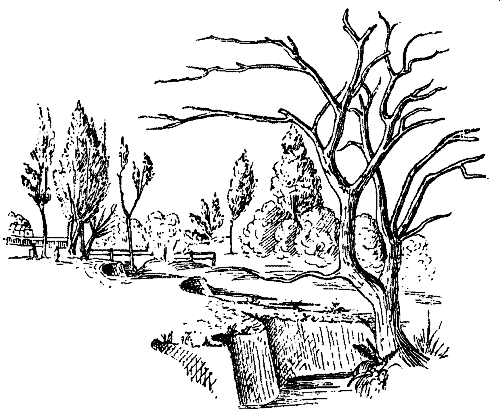
[Illustration: THE FLEET, KENTISH TOWN. _Circa_ 1837.]
Here we see the Fleet running its quiet course--and the other sketches bear witness to its rurality.
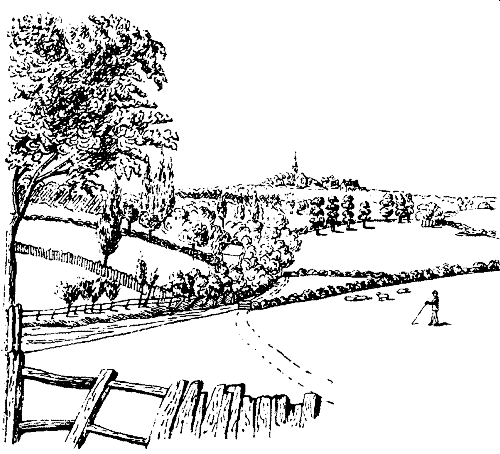
[Illustration: VIEW OF THE VALLEY OF THE FLEET AND HIGHGATE CHURCH, FROM FORTESS TERRACE, KENTISH TOWN, SEPT. 28, 1845.
(_Water colour by A. Crosby._)]
After the Fleet had recrossed the Highgate Road near the junction of that road and the Kentish Town Road, it passed near the _Gospel Oak_, which now gives its name to a railway station in the locality. About this oak, there was a tradition that it was so called because St. Augustine preached underneath its boughs--a fact which is probably as correct as the story that the Church of St. Pancras was the first Christian Church in England. In truth, there are, or were, many Gospel Oaks and Elms throughout the country; for instance, there is an iron foundry near the parishes of Tipton and Wednesbury called _Gospel Oak Works_. It was, as a matter of fact, a traditionary custom, in many places, when, on Holy Thursday (Ascension Day), the parochial bounds were beaten, to read a portion of the Gospels under some well-known tree, and hence its name. One or two quotations will easily prove this.
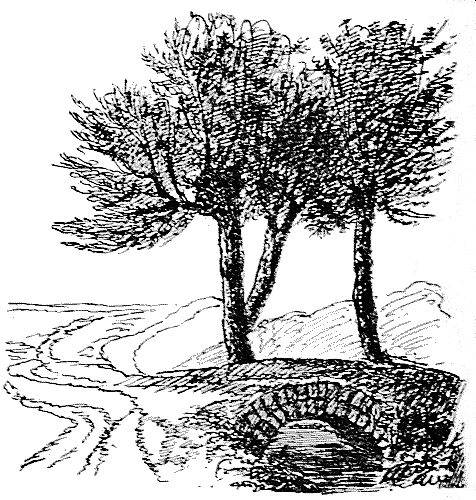
[Illustration: THE FLEET AT KENTISH TOWN.]
In the "Bury Wills," p. 118, is the following passage in the will of John Cole of Thelnetham, dated May 8, 1527: "Item, I will haue a newe crosse made according to Trappett's crosse at the Hawe lanes ende, and set vp at Short Grove's end, where the gospell is sayd vpon Ascension Even, for y^e w^{ch} I assigne x^s."
And, in the poem of Herrick's "Hesperides," which is addressed "To Anthea."
"Dearest, bury me Under that holy Oke, or Gospel Tree; Where, (though thou see'st not,) thou may'st think upon Me, when thou yerely go'st procession."
It also passed near Parliament, or Traitors', Hill--a name which is much in dispute; some maintaining that it was fortified by the Parliamentary Army, under Cromwell, for the protection of London, others that the 5th of November conspirators met here to view the expected explosion of the Houses of Parliament. This, which forms the most southern part of Hampstead Heath, and therefore the nearest, and most accessible to the great bulk of Londoners, has a beautiful view of Highgate and London, and has, I am happy to say, been preserved as an open space for the public.
![Illustration: THE FLEET AT KENTISH TOWN.]](FLEETATKENTISHTOWN2.gif)
[Illustration: THE FLEET AT KENTISH TOWN.]
We have now followed the Fleet in its course to Kentish Town, the etymon of which is, to say the least, somewhat hazy. Being so, of course, an immense amount of theory has been expended upon it. Some contend that it springs from the Prebendary attached to St. Paul's Cathedral, of Cantelupe, or Cantelows, now (in _Crockford_, called Cantlers): one antiquary suggesting that it owes its name to the delta formed by the junction of the two branches of the Fleet--from _Cant_ or _Cantle_, a corner;--whilst yet another authority thinks that, as the Fleet had its source from Ken Wood--it was called Ken-ditch--hence Kenditch or Kentish Town. Be it as it may, it was a very pleasant and rural suburb, and one of some note, for herein William Bruges, Garter King-at-Arms, had a country house, at which he entertained, in the year 1416, the Emperor Sigismund, who came over here, in that year, to try and mediate between our Henry V. and the King of France.
In still older times it formed part of the great Middlesex forest, which was full of wolves, wild boars, deer, and wild oxen; but we find that, in 1252, Henry III. granted to Thomas Ive, permission to inclose a portion of the highway adjoining his mansion at Kentessetone. And in 1357, John of Oxford, who was Mayor of London in 1341, gave, amongst other things, to the Priory of the Holy Trinity, in London, a mill at Kentish Town--which, of course, must have been turned by the Fleet. The kind donor was one of the very few Mayors who died during his mayoralty.
It is said, too, that Nell Gwynne had a house in Kentish Town, but I can find not the slightest confirmation of the rumour; still, as there is a very good pen-and-ink sketch of the old house said to be hers, I give it, as it helps to prove the antiquity of Kentish Town, now, alas! only too modern.
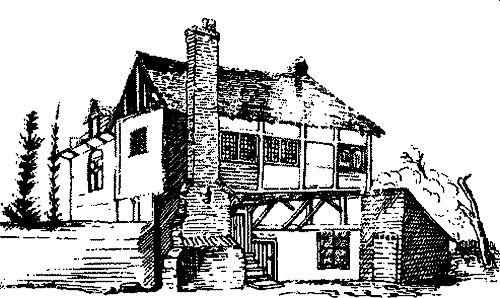
[Illustration: OLD HOUSE, KENTISH TOWN, SUPPOSED TO HAVE BEEN NELL GWYNNE'S.]
And there was another old house close by the Fleet there, an old farmhouse known as Brown's dairy.
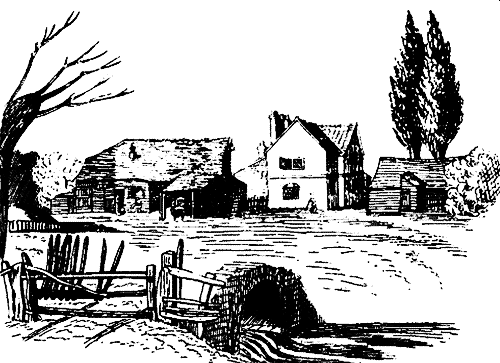
[Illustration: THE FLEET AT KENTISH TOWN--BROWNE'S DAIRY FARM, SEPT. 21, 1833.
(_By A. Crosby--water colour._)]
This old Farmhouse had, evidently, a nobler origin, for it was moated; and, in 1838, the moat existed on the east and north sides. It belonged to the College of Christ Church, Oxford, and was held of the Manor of Cantelows at a small fine. There was a good orchard, which at the above date (the time of its demolition) contained a large walnut tree and some mulberry trees. The building materials were sold for L60, so that it evidently had done its work, and passed away in the ripeness of old age.
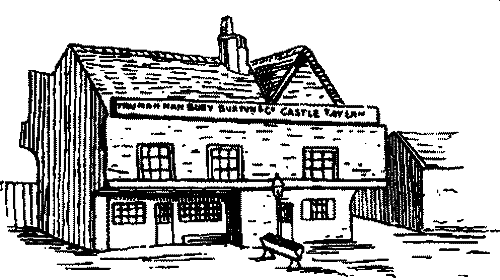
[Illustration: CASTLE, KENTISH TOWN ROAD, 1848.]
The Castle Inn is said to have been the oldest house in Kentish Town, and there is a tradition that Lord Nelson once lived here, "in order that he might keep his eye upon the Fleet," and planted a sycamore in the garden.
Before taking leave of Kentish Town, I cannot help recording a legal squabble, which resulted in a victory for the public.--_Times_, February 12, 1841:--
"COURT OF QUEEN'S BENCH, _Thursday, February 11, 1841_. (Sittings at Nisi Prius, at Westminster, before Lord Denman and a special jury.)
"THE QUEEN _v._ TUBB.
"This was an Indictment against the Defendant for obstructing a footpath leading from Pond Lane, at Hampstead, over Traitors' and Parliament Hill, to Highgate.
"The case lasted the whole day.
"The jury brought a verdict for the Crown, thus establishing the right of the Public to one of the most beautiful walks in the neighbourhood of the metropolis."
The Fleet babbled through the meadows, until its junction with that other stream which flowed from the pond in the Vale of Health at Hampstead, which took place where now is Hawley Street, and the united brook, or river, ran across what are now the Kentish, and Camden, Town Roads, and between Great College Street, and King Street; it then followed the course of the present road to King's Cross, passing by St. Pancras Church--which, originally, was of great antiquity, and close by which was a celebrated healing well, known as Pancras' Wells. These waters cured everything--scurvy, king's evil, leprosy, cancers, ulcers, rheumatism, disorders of the eyes, and pains of the stomach and bowels, colds, worms, &c., &c.
In the Church, and Churchyard, were interred many illustrious dead, especially Roman Catholics, who seem to have taken a particular fancy to have their remains buried there, probably on account of the tradition that this was the last church in which mass was celebrated. It was a favourite burial-place of the French clergy--and a story is told (how true I know not) that, down to the French Revolution, masses were celebrated in a church in the south of France, dedicated to St. Pancras, for the souls of the faithful interred here.
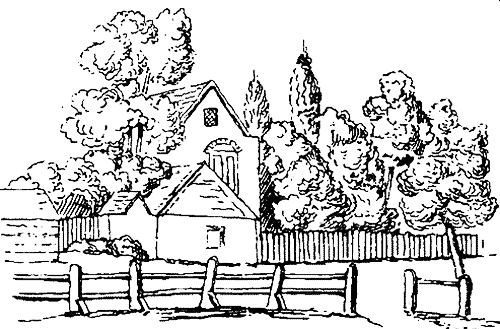
[Illustration: THE BRILL.]
Many historical names are here preserved--amongst whom are Pasco de Paoli, the famous Corsican; Walker, whose dictionary is still a text book; the Chevalier d'Eon, respecting whose sex there was once such a controversy; Count O'Rourke, famous in the world of fashion in 1785; Mrs. Godwin--better known, perhaps, as Mary Woolstencraft--who also was married here; William Woollett, the eminent landscape engraver, a branch of art in which he may be said to have been the father; Samuel Cooper, whose miniatures cannot be surpassed; Scheemaker the younger, a sculptor of no small note. Nor in this _campo santo_ was Music unrepresented, for there, amongst others, lie the bodies of Mazzinghi, who brought the violin into fashion here in 1740; and Beard, a celebrated singer in 1753. The river flows hence to Battle Bridge, or King's Cross, as it is now termed, forming in its way a sort of pond called "Pancras Wash," and running through a low-lying district called "The Brill."[17] This peculiarly unsavoury neighbourhood has now been cleared away, in order to afford siding room, &c., for the Midland Railway.
But Dr. Stukeley, who certainly had Roman Camps on the brain, discovered one in the Brill. He planned it out beautifully. Here were the Equites posted, there the Hastati, and there were the Auxiliarii. He made the Fleet do duty for a moat which nearly surrounded Caesar's Praetorium, and he placed a Forum close by St. Pancras' Church, to the northward of which he assigned a Praetorium to Prince Mandubrace. Is it not true? for is it not all written in his "Itinerary"? and does he not devote the first seventeen pages of the second volume of that work, entirely to the Brill, assuring us of the great pleasure he received in striding over the ground--following, in imagination, the footsteps of the Roman Camp Master, who _paced_ out the dimensions of the Camp?
Trying to avoid privacy and cookie settings overwriting content